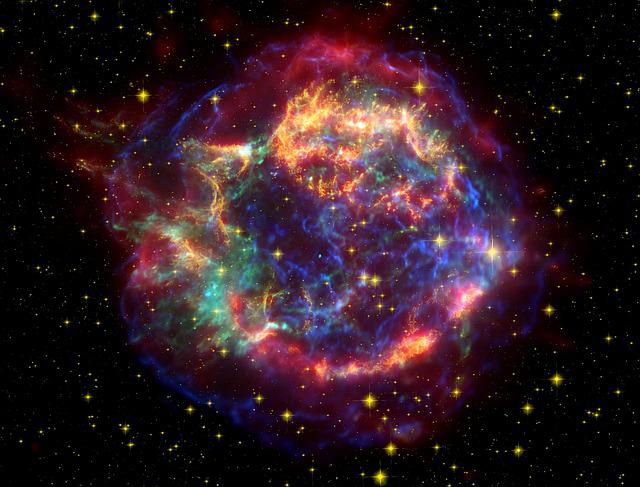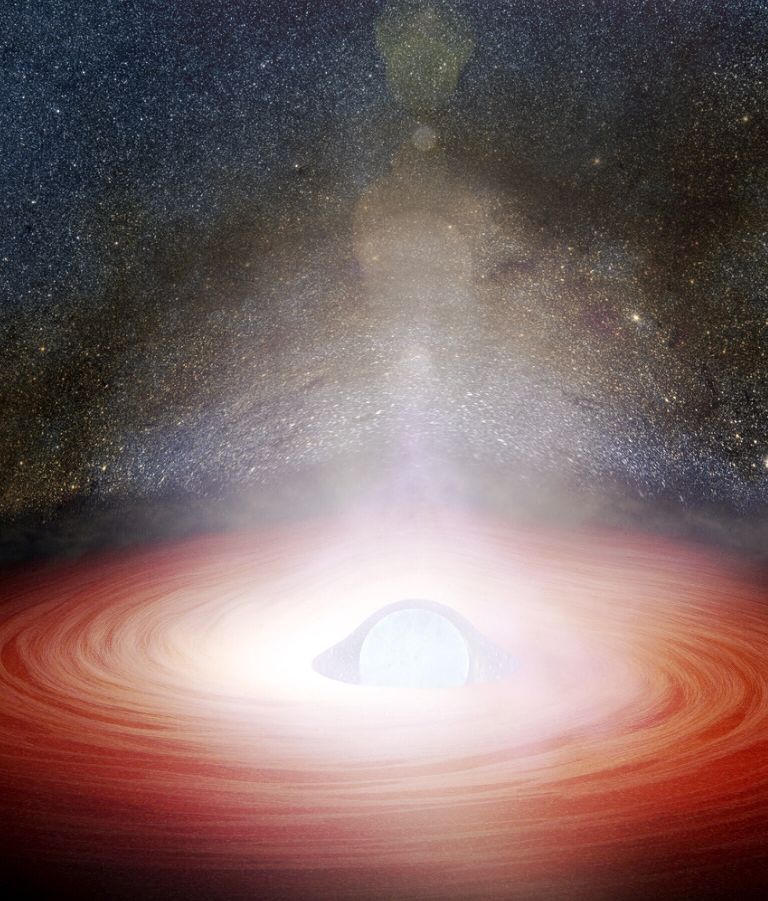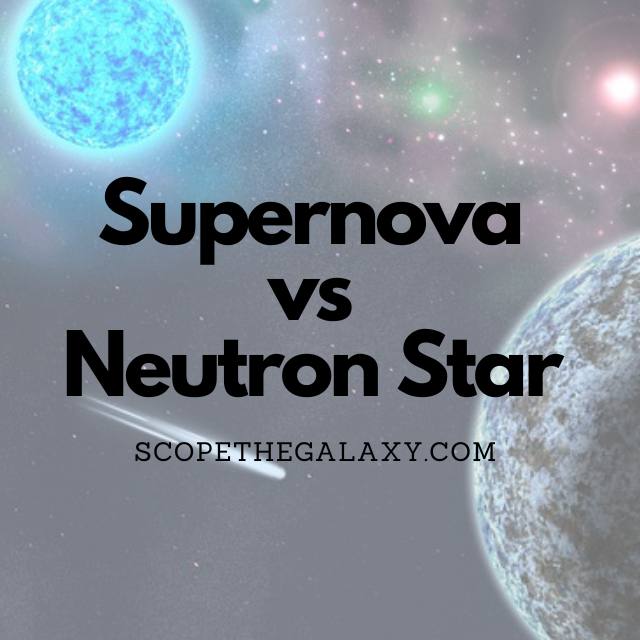*This post may contain affiliate links. This means we may make a commission if you purchase an item using one of our links*
Supernovae and neutron stars are interconnected as one precedes the other. Supernova explosions are simply the phase just before a neutron star is formed.
The main differences between the two are that supernovae are over 100 times hotter, they’re many time larger in size and can also create black holes depending on the solar mass of the exploding star. Neutron stars are more dense, have a lifespan potentially 100 billion times longer and are the stellar remnants of a dead star.
For a more thorough breakdown of both entities, the similarities between the two as well as the plethora of other differences between them, continue reading.
What Is A Supernova?
Table of Contents

Supernovae a classified under 2 different types where a type 1 supernova is an explosion that leaves no hydrogen line emissions in the spectra and a type 2 supernova is distinguished where a star 15 times the mass of our sun explodes and does produce hydrogen line emissions.
There are two ways that a supernova explosion can form.
It can either be via a white dwarf in a binary star system that accumulates too much energy from its companion star causing it to explode or when a larger star runs out of nuclear fuel and collapses under its own gravity, leaving behind the bright and grandiose remnants of this explosion many times brighter than even its own galaxy.
As stated above supernovae are generally split into 2 types, a type 1 supernova or a type 2. Type 1’s are then further split into 1 of 3 subcategories, Ia, Ib or Ic.
A type 1a supernova is the most commonly observed in outer space and acts like a candle light to help us observe distance across the deep unknown.
These are theorised to form after a white dwarf, likely in a binary star system, exploding due to the over consumption of energy from its companion. Type Ia’s have a strong silicon absorption line near its maximum luminosity whilst producing no hydrogen at the same time
Type Ib’s are formed after a large star collapses under its own core gravity where the outer region of the stars hydrogen is stripped away, leaving behind only second layer of helium that remains.
Type Ic’s lack both the hydrogen and helium layer when they explode, although the difference here has been debated as not being significant enough to differentiate a type Ib from a Ic.
Type 2 supernovae are formed when a star between 8 – 50 times the Sun’s mass collapses into itself and causes a huge explosion that produces a black hole in most cases. This is because black holes require an explosion from a star to leave behind at least 3 solar masses of materials.
In essence anything above 20 times the size of our Sun can potentially result in a black hole whilst a white dwarf star that is 1.44 solar masses or between 10 – 20 times the mass of our Sun would produce a neutron star instead.
What Is A Neutron Star?

When a star 10 to 20 times more massive than our own sun or more massive than the Chandrasekhar limit of 1.44 solar masses, reaches the end of its life, the core collapses, and the outer matter explodes in a supernova. A neutron star is what would remain at the center of the explosion.
Neutron stars can come in two main varieties, acting either as an active pulsate pulsar or a or the more erratic and powerful magnetars.
The neutron star gets its name from the fact that after the initial explosion of the star, gravity presses the remaining material so tightly that it forces protons and electrons to combine and form neutrons.
If the star’s mass is greater than 20 times our sun’s, this reaction is likely to create a black hole. While black holes are almost impossible to observe, neutron stars are straightforward, thanks to pulsating light.
A neutron takes a mass greater than twice the sun’s mass and condenses it into a spherical object no bigger than one of Earth’s cities. These mysterious objects are still not entirely understood by scientists.
The atmosphere of a neutron star comprises hydrogen, helium, and carbon. The outer crust contains ions and electrons, while the inner crust contains ions and superfluid neutrons. The outer core is superconducting protons, but what exactly comprises the inner core? That fact remains unknown.
The gravity of these objects is so strong that it literally bends its light waves around its body, making it easier for scientists to determine the size and mass of these stars.
Is A Neutron Star Bigger Than A Supernova?
No, a neutron star will never be bigger than the explosion that makes it. These entities will typically be around 15 – 25km in size which in the grand scheme of the entire universe is miniscule whilst supernova explosions literally expand at many times that (between 15,000 to 40,000 km per second).
Considering the density and magnetic fields of neutrons stars, it only makes sense that such as massive explosion would be necessary in order to create them.
Similarities Between A Supernova And Neutron Star
Other than the fact a supernova explosion is the phase the precedes the creation of the neutron star, the two entities are very different from one another, whether it be size, temperature and a multitude of other reasons, of which I’ll be going over below.
Differences Between A Supernova And Neutron Star
The differences between a supernova explosion and a neutron star would include the following:
- Neutron stars are a dense ball of neutrons packed together whilst supernova explosions are mostly made of plasma.
- Supernova explosions are formed when either a white dwarf around 1.4 solar masses in size explodes or larger star around 8+ solar masses explodes. Neutron stars are just the remnants of the explosion.
- Supernova explosions can create both black holes and neutrons stars. This is dependent on if the explosion leaves behind 3+ solar masses of material behind.
- Neutron stars, with the magnetar variants in particular, have amongst the strongest magnetic fields in the universe whilst supernovae do not.
- Supernova explosions will last for at most a few months whilst neutron stars have an estimated lifespan of 100+ billion years.
- Neutron stars are scorching hot where they would be roughly be 670,000 °C but, supernovae are even hotter, exceeding the billion degrees celsius range.
- Neutron stars are able to affect space and time around them where they are even able to dilate time by around 30%.
- Supernova explosions tend to shine so bright, even eclipsing the brightness of entire galaxies whilst neutron stars are even dimmer than our Sun, which is mostly down do its minuscule size in comparison to other celestial bodies.
Summary
In short, the only way a supernova and a neutron star connect is through how one just occurs before the other is created. Other than that, neutron stars are a compressed, densely packed collection of neutrons whilst supernovae are bright, scorching hot, freeform dust clouds spread across their outer space region.
They are just very different entities from each other even if they are both phases that a star will go through.

